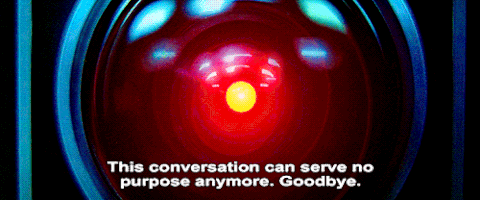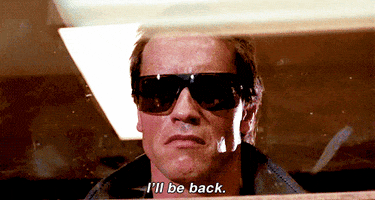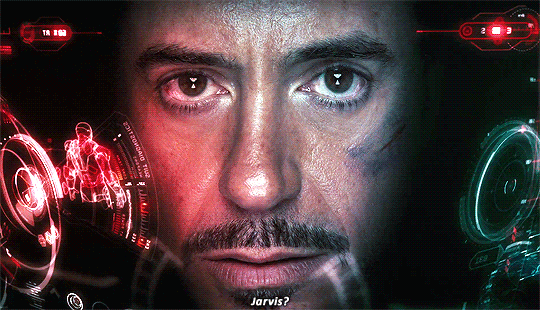Intelligence created by humans can be found in ancient traditions long before our time, and the first humanoid robots naturally appeared in literature with the Industrial Revolution. Cinema took up the theme very early, with Fritz Lang’s Metropolis in 1927. The first trace of artificial intelligence appeared in 1957 in Herman Hoffman’s The Invisible Boy. Since then, AI has occupied a prominent place in cinema (and TV series) and have been an endless source of fantasy for Hollywood screenwriters.
But is all that fantasy really pure fiction? who is really influencing who in science and who in cinema?
⚠️ WARNING: The AI world is moving very fast at the moment. By the time you read this, the truth may have already changed…
🚨 SPOILER ALERT: It is possible that for the understanding of this article, we reveal some key elements of the films taken as examples*.
2001, A Space Odyssey, Stanley Kubrick (1968)

| AI | Name: HAL 9000 Date of creation: 1992 Date of operation: 2001 |
| Features | – Pilot Spacecraft – Make complex conversations – Read lips – Recognise faces – Interpret emotions – Play chess |
| Personality | Can suffer from nervous breakdown and become dangerous |
The AI: HAL 9000 is the on-board AI of the Discovery One spacecraft. HAL (which stands for IBM if you move the three letters +1 to the left) stands for Heuristically Programmed Algorithmic. Developed in 1992, HAL can pilot the spacecraft completely autonomously, holding a complex conversation with the crew, reading lips, recognising faces, interpreting emotions and playing (and winning) chess.
In 1968, no AI was capable of this level of language comprehension, and even today none can hold a complex conversation with a human. HAL has a conscience and the ability to make decisions for itself, which leads it to kill the crew because it considers them a threat to the mission for which it was configured. The dark side of HAL 9000 is pure fiction in Kubrick’s mind, fortunately for us.
Some of the features of HAL 9000 are inspired by reality or have been proven to be true in the future, such as the fact that HAL autonomously controls Discovery, although it is still a long way from the level of autonomy in cars, for example. Most striking is HAL’s ability to play and win at chess, reminiscent of the games between Deep Blue in 1999 and champion Garry Kasparov in 1996-1997.
Fun fact: Marvin Minsky, director of the MIT Computer Science and Artificial Intelligence Laboratory (CSAIL) and one of the most influential researchers in the field, was an adviser on the film set. In the mid-1960s, many computer scientists in the field of artificial intelligence were optimistic that machines with HAL’s capabilities would exist within a few decades. For example, AI pioneer Herbert A. Simon at Carnegie Mellon University, had predicted in 1965 that “machines will be capable, within twenty years of doing any work a man can do” (Wikipedia)
Terminator, James Cameron (1984)

| AI | Name: T-800 aka The Terminator Date of creation: 2027 Date of operation: 1984 |
| Features | – Speak like human – Make autonomous decision – Learn by it-self – Breathe, sweat and bleed – Copy human behaviors |
| Personality | Can’t feel any emotion |
The AI: There are 2 AIs in Terminator. First, Skynet takes control by triggering a nuclear cataclysm and waging war against humanity to establish machine supremacy. Skynet sends a Terminator (model T-800), a human-looking cybernetic soldier, back in time to 1984 to kill Sarah Connor, the mother of the leader of the Resistance, and prevent her from being born retroactively. A scenario of the domination of the machine over man, which is also found in The Matrix. But let’s get back to the Terminator. Conceived in 2029 (it’s coming!), it has its own intelligence, a human appearance and speak fluent but has no free will. The Terminator comes from the future and constantly analyses its surroundings in order to learn to adapt quickly by imitation, as when it “borrows” the clothes of a biker and his motorbike. Proof that the machine is not perfect comes at the beginning of the film when he fails to identify the right Sarah Connor and kills the wrong one. Much later in the saga, the new versions of the Terminator are more evolved and increasingly self-aware.
The dystopian vision of Skynet and the ‘machine uprising’ is clearly one of the fears of AI in the 1980s and still today. But this may be a topic for future discussion.
The Terminator is interesting because it embodies the idea of AI: a stronger, more violent, more intelligent humanoid robot. There was no equivalent in the 1980s. Today, science has joined fiction, with Boston Dynamics and Sophia, for example. The Terminator’s limited language level is feasible, as is the widespread use of object recognition in many applications. After all, version 1 of the Terminator is not far away, only from a functional and theoretical point of view.
Iron Man, John Favreau (2008)

| AI | Name: J.A.R.V.I.S then replaced by F.R.I.D.A.Y Movie: Iron man (& Avengers) Date of creation: 2015 Date of operation: 2008-2015 |
| Features | – Make (very) complex conversation – Make autonomous decision – Can understand scientific concepts and make research – Act like a wingman – Pilot Iron Man suit |
| Personality | Sense of humour, clumsy |
The AI J.A.R.V.I.S. for Just A Rather Very Intelligent System, is the visual and vocal interface built into Tony Stark/Iron Man’s armour. J.A.R.V.I.S can have complex conversations and making decisions completely autonomously. As the series progresses, JARVIS takes on more and more responsibility, assisting Tony Stark even in his scientific developments. He will be replaced by an even more advanced AI F.R.I.D.A.Y. (Female Replacement Intelligent Digital Assistant Youth) in 2015.
J.A.R.V.I.S. is clearly reminiscent of the HUDs (Head Up Displays) installed in aircraft cockpits to display important information in the pilot’s field of vision, or the automation of certain on-board systems to make work easier; these technologies are now widely used. The most interesting thing about JARVIS and FRIDAY is their ability to carry on a very complex natural language discourse or even to make jokes, their ability to process abstract concepts, to make decisions autonomously and to act like a real human wingman. FRIDAY goes even further when she expresses feelings towards Tony Start, falls in love with him and gets angry when Tony stops using her.
However, this humanisation, pushed beyond the limit, remains in the area of fiction. In fact, an AI, however conversational, does not understand either the input or the output data, so it is hard to imagine a brainstorming session between a human and an AI to build a hyper-complex system.
Conclusion
Overall, the reality of AI technology in the real world is much more limited and focused than what can emerge from the fertile minds of Hollywood screenwriters. Although AI is a rapidly developing field, it has a long way to go before it reaches the level of sophistication and capability often portrayed in science fiction.
But while it would be an exaggeration to say that these films have influenced current scientific development, it is fair to say that scientists and engineers dream as much as we do when they watch these films.
It is interesting to note that the filmmakers are always guided by well-known names (people and/or research institutions), so that the use of technology is not only beautiful, but also realistic. No, most of the things shown are not yet possible, but they might be in ten years’ time. And that is why these film references are often used to position the newly developed technology: to explain exactly what has been done and why it is so fantastic.
* We have made the cornelian and subjective choice here by selecting 3 films that represent their time with 2001: A Space Odyssey (1968), Terminator (1984) and Iron Man (2008).
Of course, there is an endless list of films like Ex-Machina, Her, The Knight Rider, Star Trek, Blade Runner, Her, Star Wars, Minority Report or even Demolition Man that would have deserved to be here.